Introduction to Halal Diet Food Recipes
When we talk about food, it’s not just about satisfying hunger—it’s also about values, culture, and faith. For Muslims, the concept of Halal is at the very heart of what they consume. A halal diet is more than just a religious requirement; it’s a complete lifestyle that emphasizes purity, wholesomeness, and ethical eating. Halal food is not restricted to a single culture or region—it’s enjoyed across the globe in countless delicious variations, from Middle Eastern delicacies to Asian curries and Western fusion dishes.
One of the most beautiful things about halal cooking is that it respects both the body and the soul. Every bite is prepared with the assurance that it is permissible, clean, and beneficial. Whether you are a Muslim committed to halal principles, or someone simply interested in exploring healthier, ethically sourced meals, halal recipes provide a world of flavor and nourishment.
In this article, we’ll dive deep into halal diet food recipes—covering everything from traditional meals to modern-day dishes you can make at home. Along the way, we’ll explore the essential rules of halal eating, the staple ingredients, and a variety of recipe ideas to spice up your kitchen routine. By the end, you’ll have a full guide to creating mouthwatering halal dishes for breakfast, lunch, and dinner.
Understanding the Concept of Halal
Halal is an Arabic word that means permissible or lawful. When applied to food, it refers to what Muslims are allowed to eat according to Islamic law. Just as there are rules in many religions regarding food—like kosher in Judaism—halal ensures that the preparation, ingredients, and handling of food meet specific ethical and spiritual guidelines.
For example, meat must come from animals that are slaughtered in the name of God, with compassion and respect. Foods like pork and alcohol are strictly forbidden (haram), while fruits, vegetables, grains, and halal-certified meat form the basis of the halal diet.
It’s important to note that halal eating is not limited to religious observance. Many non-Muslims also prefer halal food because it is often fresher, cleaner, and produced with higher ethical standards. Restaurants and supermarkets around the world are recognizing this growing demand and offering more halal-certified products than ever before.
In essence, halal isn’t just a diet—it’s a conscious way of living that ties food to spirituality, ethics, and health. Understanding this foundation makes it easier to appreciate the richness of halal recipes.
Importance of Halal Food in Daily Life
For Muslims, halal food is not a choice—it’s a command from their faith. The Quran emphasizes consuming only what is pure and lawful, making food not just about taste but also about obedience to God. This means every meal becomes an act of worship, a way to stay spiritually aligned while enjoying physical nourishment.
But beyond faith, halal food carries a deeper significance. It promotes cleanliness, kindness to animals, and fair trade practices. Many halal certifications require strict hygiene standards, ensuring that what reaches the plate is of the highest quality. This makes halal food appealing to a much broader audience, especially in today’s world where people are more health-conscious and environmentally aware.
In daily life, halal food also strengthens cultural identity and family bonds. Sharing a halal meal with loved ones often means celebrating traditions, recipes passed down for generations, and moments of togetherness. It’s not unusual for halal recipes to be filled with vibrant flavors, colorful spices, and hearty portions—making every dining experience something to look forward to.
So, when you think about halal food, don’t just picture rules and restrictions. Think about it as a lifestyle that connects faith, health, and community through the universal joy of food.
The Principles of Halal Eating
To cook and eat halal, it’s important to know the principles behind it. Halal eating revolves around two main ideas: what is allowed (halal) and what is forbidden (haram). For example, pork, blood, and intoxicants are forbidden. Meat is only halal if the animal is slaughtered in the correct way, with a prayer said before the act, ensuring the process is both humane and spiritually conscious.
Another principle is avoiding cross-contamination. If halal food is prepared with utensils or surfaces that have touched haram food, it is no longer considered permissible. This is why many restaurants and food brands maintain separate kitchens or facilities to keep halal food pure.
Interestingly, halal eating is not about limiting choices—it’s about choosing wisely. By focusing on wholesome, clean, and ethical food, halal eating naturally aligns with modern health trends like organic produce, sustainable farming, and mindful consumption.
These principles guide Muslims in making everyday choices, from grocery shopping to dining out, ensuring that every meal aligns with their values.
What Makes Food Halal or Haram
The difference between halal and haram is clear but deeply significant. To understand halal recipes, you first need to know what makes food permissible or forbidden:
- Halal Foods Include:
- All fruits, vegetables, grains, and legumes
- Seafood
- Halal-certified meat (beef, lamb, chicken, goat, etc.)
- Dairy products (if free from haram additives like animal rennet from non-halal sources)
- Haram Foods Include:
- Pork and its by-products (bacon, gelatin from pork, lard, etc.)
- Alcohol in any form (including cooking wine and extracts made with alcohol)
- Carnivorous animals and birds of prey
- Meat not slaughtered according to Islamic rules
By sticking to halal-approved foods, Muslims ensure that their meals are both spiritually pure and physically beneficial. With these boundaries in mind, the world of halal recipes opens up to endless creativity, blending flavors from different cuisines while staying within the guidelines.
Breakfast Halal Recipes
1-Shakshuka (Eggs in Tomato Sauce)
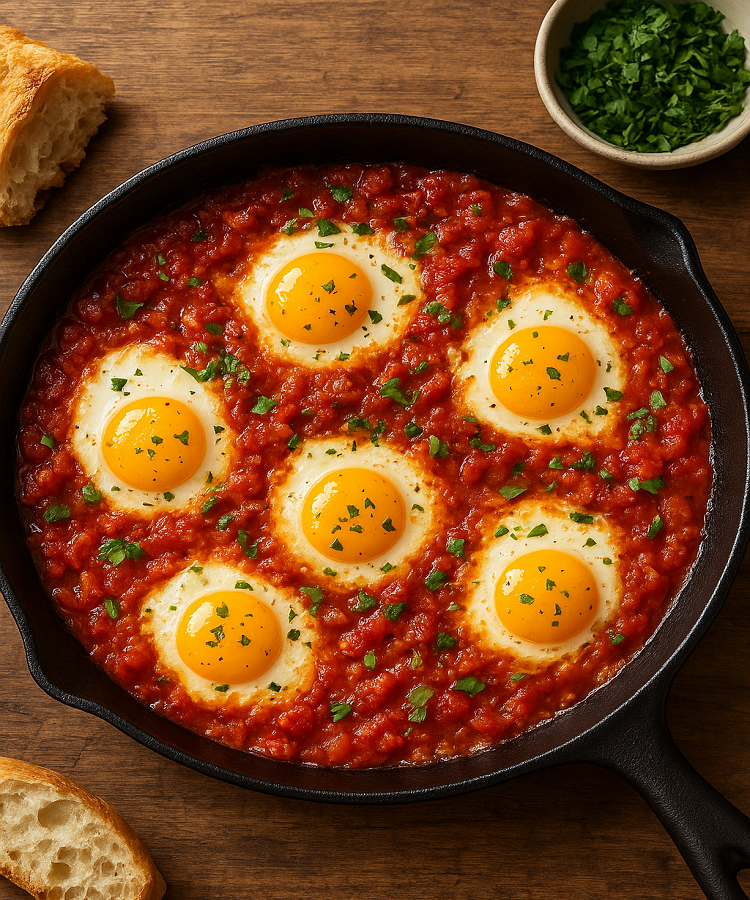
Ingredients (serves 4):
- 2 tbsp olive oil
- 1 large onion, diced
- 1 red bell pepper, diced
- 3 garlic cloves, minced
- 1 tsp ground cumin
- 1 tsp ground paprika
- ½ tsp chili flakes (optional)
- 1 can (28 oz) crushed tomatoes
- Salt and pepper to taste
- 4–6 large eggs
- Fresh parsley or cilantro, chopped (for garnish)
- Crumbled feta (optional)
- Warm pita or crusty bread (for serving)
Instructions:
- Heat olive oil in a large skillet over medium heat. Add onion and bell pepper; cook until softened, ~5 minutes.
- Stir in garlic, cumin, paprika, and chili flakes. Cook until fragrant, ~1 minute.
- Add crushed tomatoes, season with salt and pepper, and simmer for 10–12 minutes until sauce thickens.
- Make small wells in the sauce and crack eggs into each. Cover with a lid and cook until whites are set but yolks are still runny, ~6–8 minutes.
- Garnish with parsley/cilantro and optional feta. Serve hot with bread.
2-Quinoa Tabbouleh Salad
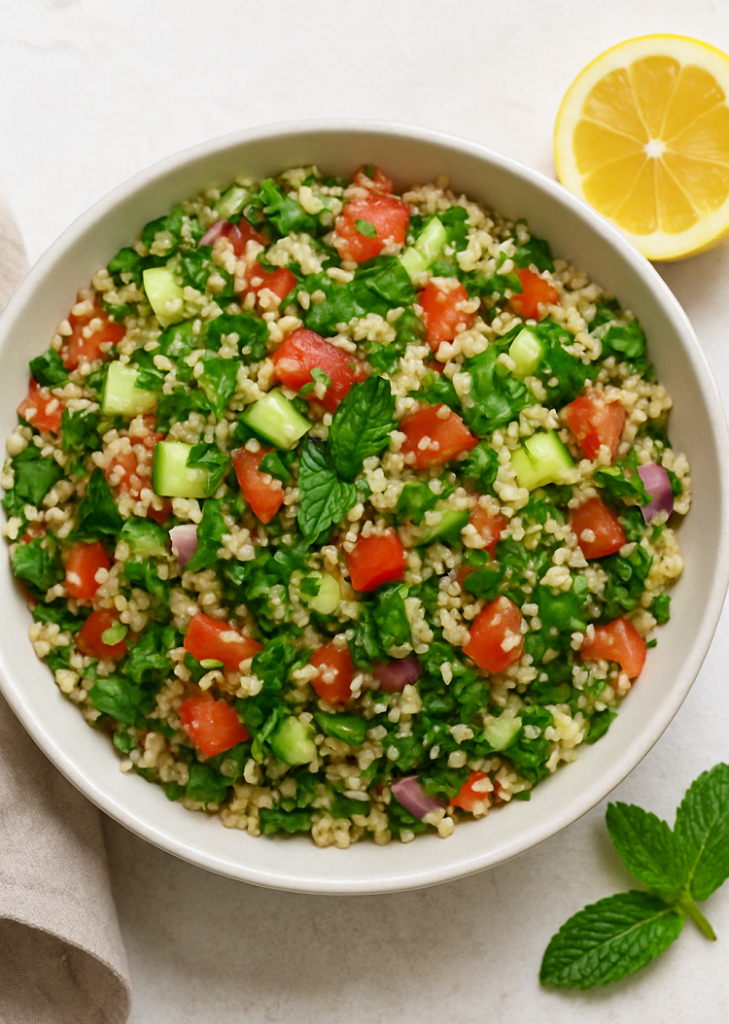
Ingredients (serves 4):
- 1 cup quinoa, rinsed
- 2 cups water
- 2 cups fresh parsley, finely chopped
- ½ cup fresh mint, finely chopped
- 1 cucumber, diced
- 2 medium tomatoes, diced
- 4 scallions, finely sliced
- ⅓ cup olive oil
- Juice of 2 lemons
- Salt and pepper to taste
Instructions:
- Cook quinoa: bring quinoa and water to a boil, reduce to low, cover, and simmer for 15 minutes. Fluff with a fork and let cool.
- In a large bowl, combine parsley, mint, cucumber, tomatoes, and scallions.
- Add cooled quinoa, olive oil, lemon juice, salt, and pepper. Toss to combine.
- Chill for at least 30 minutes before serving.
3-Mediterranean Hummus Wrap
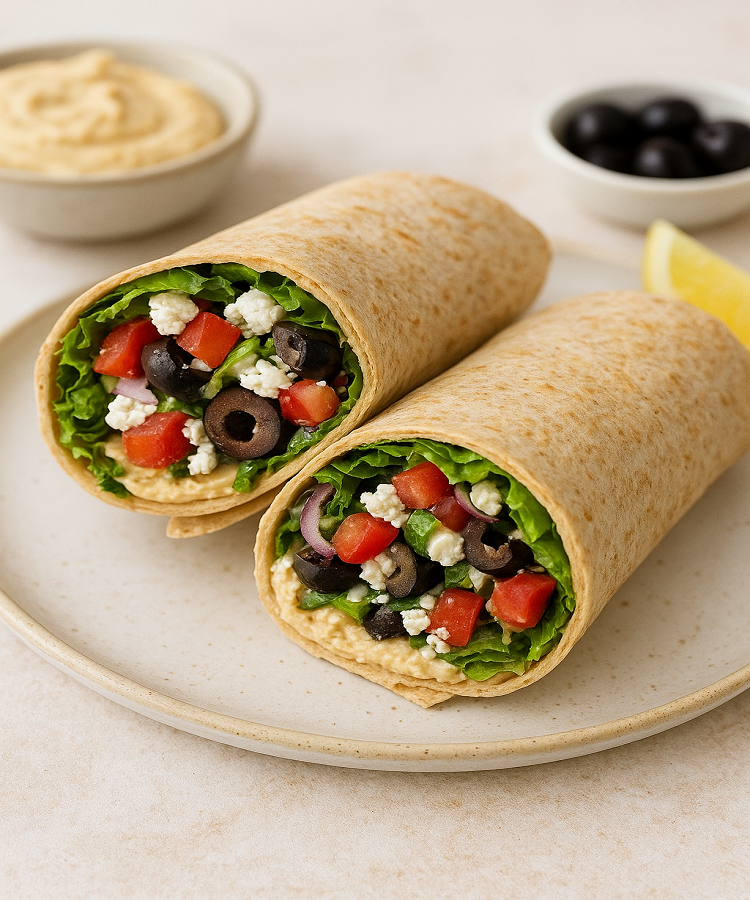
Ingredients (makes 4 wraps):
- 4 large whole wheat tortillas or flatbreads
- 1 cup hummus (store-bought or homemade)
- 1 cucumber, thinly sliced
- 1 tomato, thinly sliced
- 1 small red onion, thinly sliced
- 1 cup mixed greens (lettuce, spinach, or arugula)
- ½ cup crumbled feta (optional)
- Kalamata olives, sliced (optional)
Instructions:
- Spread ~¼ cup hummus over each tortilla.
- Layer cucumber, tomato, onion, greens, and optional toppings.
- Roll tightly, slice in half, and serve immediately or wrap in parchment for later.
4-Spiced Lentil Soup
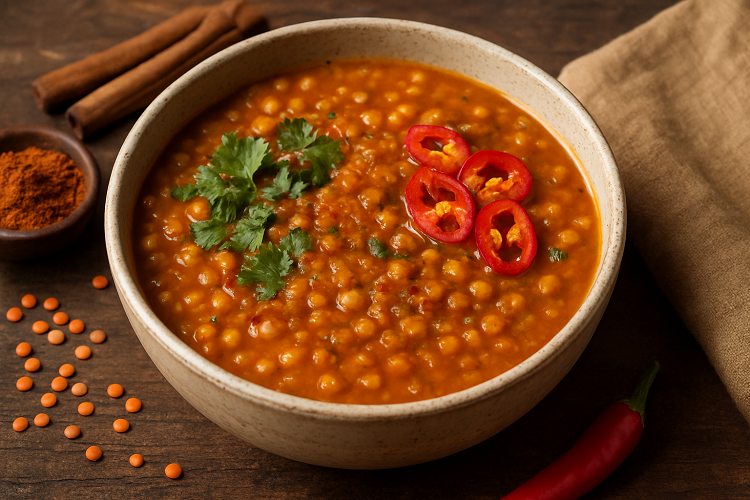
Ingredients (serves 6):
- 2 tbsp olive oil
- 1 large onion, diced
- 2 carrots, diced
- 2 celery stalks, diced
- 3 garlic cloves, minced
- 2 tsp ground cumin
- 1 tsp turmeric
- 1 tsp smoked paprika
- 1 cup red lentils, rinsed
- 1 can (14 oz) diced tomatoes
- 6 cups vegetable broth
- Salt and pepper to taste
- Juice of 1 lemon
- Fresh parsley for garnish
Instructions:
- Heat olive oil in a large pot. Add onion, carrots, and celery; sauté 5–7 minutes.
- Stir in garlic and spices; cook until fragrant.
- Add lentils, tomatoes, and broth. Bring to a boil, then reduce heat and simmer uncovered 25–30 minutes until lentils are tender.
- Season with salt, pepper, and lemon juice.
- Garnish with parsley and serve with warm bread.
5-Honey Glazed Carrots
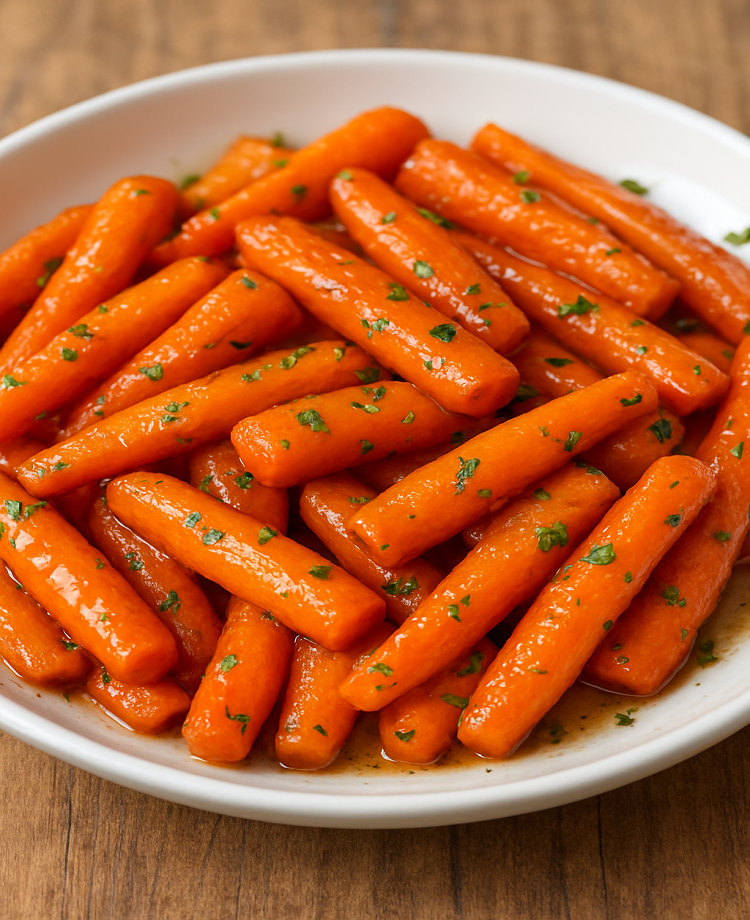
Ingredients (serves 4):
- 1 lb carrots, peeled and sliced into sticks or rounds
- 2 tbsp butter (or olive oil)
- 2 tbsp honey
- 1 tbsp fresh lemon juice
- Salt and pepper to taste
- Fresh parsley, chopped (for garnish)
Instructions:
- Bring a pot of salted water to a boil. Add carrots and cook for 4–5 minutes until just tender. Drain.
- In a skillet, melt butter over medium heat. Add honey and lemon juice, stir to combine.
- Add carrots to skillet, tossing to coat in glaze. Cook 3–4 minutes until glossy and caramelized.
- Season with salt and pepper, sprinkle with parsley, and serve warm.
Lunch Halal Recipes
6-1. Chicken and Vegetable Stir-Fry
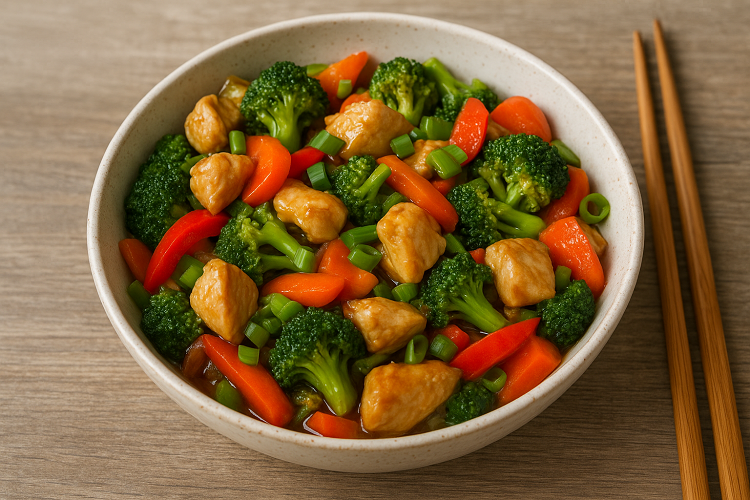
Ingredients (Serves 4):
- 1 lb (450 g) boneless, skinless chicken breast, sliced thinly
- 2 tbsp soy sauce
- 1 tbsp oyster sauce (optional)
- 1 tbsp cornstarch
- 2 tbsp vegetable oil
- 2 garlic cloves, minced
- 1-inch piece fresh ginger, minced
- 1 red bell pepper, sliced
- 1 cup broccoli florets
- 1 carrot, thinly sliced
- 1 zucchini, sliced
- 2 green onions, chopped
- 2 tbsp low-sodium soy sauce (for sauce)
- 1 tbsp sesame oil
- 1 tsp honey or brown sugar
- Sesame seeds (optional garnish)
Instructions:
- In a bowl, toss chicken with 2 tbsp soy sauce and cornstarch. Set aside for 10 minutes.
- Mix sauce: combine soy sauce, sesame oil, honey, and oyster sauce if using.
- Heat oil in a large pan or wok. Cook chicken until golden, about 5 minutes. Remove.
- In same pan, sauté garlic and ginger. Add vegetables and stir-fry 4–5 minutes until tender-crisp.
- Return chicken to pan. Pour sauce and stir until coated and slightly thickened.
- Garnish with green onions and sesame seeds.
Serving Suggestion: Serve hot over steamed jasmine rice or noodles.
7. Stuffed Bell Peppers with Rice and Vegetables
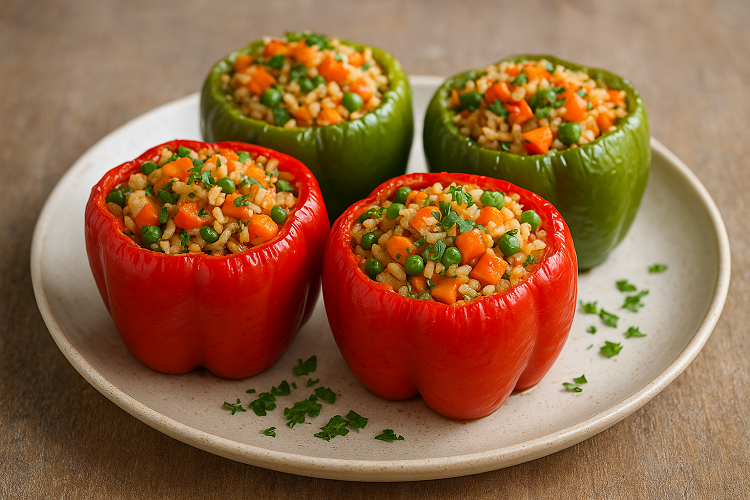
Ingredients (Serves 4):
- 4 large bell peppers (any color), tops cut off, seeds removed
- 1 cup cooked rice (white, brown, or wild)
- 1 small onion, finely chopped
- 1 zucchini, diced
- 1 cup mushrooms, diced
- 1 carrot, grated
- 2 garlic cloves, minced
- 1 can (14 oz) diced tomatoes
- 2 tbsp olive oil
- 1 tsp dried oregano
- 1 tsp paprika
- 1/2 cup shredded cheese (optional)
- Salt and pepper, to taste
Instructions:
- Preheat oven to 375°F (190°C).
- Heat olive oil in a skillet. Cook onion, garlic, zucchini, mushrooms, and carrot until softened.
- Stir in cooked rice, tomatoes, oregano, paprika, salt, and pepper. Cook 5 minutes.
- Spoon filling into peppers. Top with cheese if desired.
- Place peppers upright in a baking dish with a little water at the bottom. Cover with foil.
- Bake 30–35 minutes, uncovering for the last 10 minutes.
Serving Suggestion: Pair with a simple green salad.
8. Roasted Cauliflower with Tahini
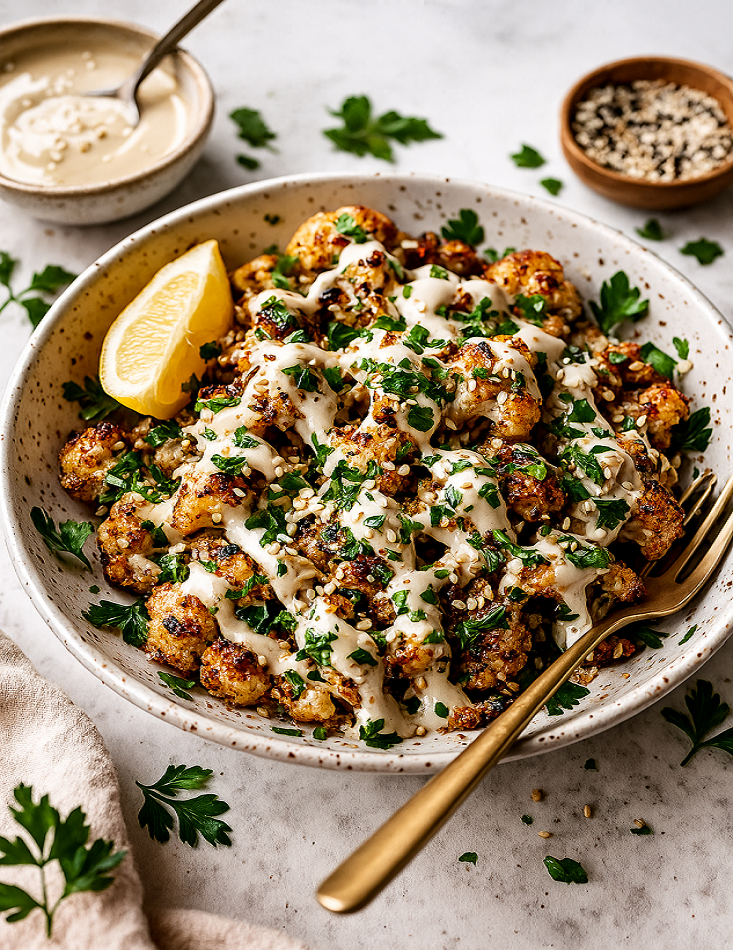
Ingredients (Serves 4):
- 1 medium cauliflower, cut into florets
- 3 tbsp olive oil
- 1 tsp cumin powder
- 1 tsp smoked paprika
- Salt and black pepper
- 1/3 cup tahini
- 2 tbsp lemon juice
- 1 garlic clove, minced
- 3 tbsp warm water (to thin sauce)
- Fresh parsley, chopped (for garnish)
Instructions:
- Preheat oven to 425°F (220°C).
- Toss cauliflower with olive oil, cumin, paprika, salt, and pepper. Spread on a baking sheet.
- Roast 25–30 minutes, flipping halfway, until golden and crispy at edges.
- Whisk tahini, lemon juice, garlic, and warm water until smooth.
- Drizzle tahini sauce over roasted cauliflower. Garnish with parsley.
Serving Suggestion: Serve as a side or over couscous or quinoa.
9. Grilled Lemon Herb Chicken
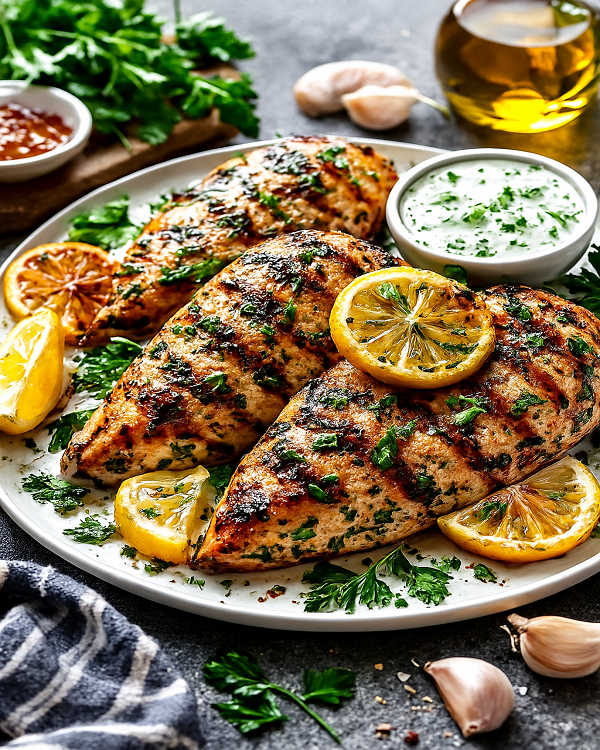
Ingredients (Serves 4):
- 4 boneless, skinless chicken breasts
- 1/4 cup olive oil
- Juice and zest of 2 lemons
- 3 garlic cloves, minced
- 1 tbsp fresh thyme (or 1 tsp dried)
- 1 tbsp fresh rosemary (or 1 tsp dried)
- 1 tsp paprika
- Salt and black pepper
Instructions:
- In a bowl, mix olive oil, lemon juice, zest, garlic, herbs, paprika, salt, and pepper.
- Place chicken in marinade for at least 30 minutes (up to 4 hours).
- Preheat grill (or grill pan) to medium-high.
- Grill chicken 6–7 minutes per side, until cooked through (internal temp 165°F/74°C).
- Let rest 5 minutes before slicing.
Serving Suggestion: Serve with roasted potatoes or a fresh Greek salad.
10. Moroccan Chickpea Stew
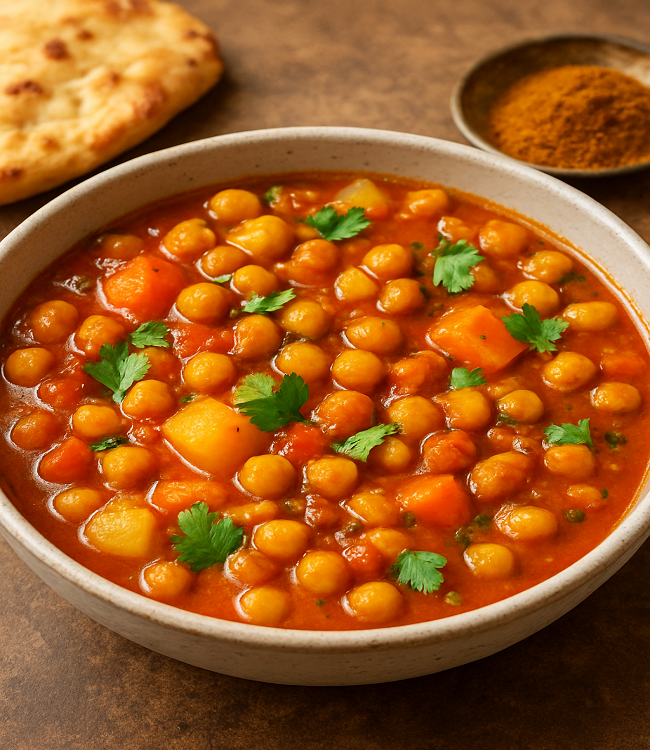
Ingredients (Serves 4–6):
- 2 tbsp olive oil
- 1 onion, diced
- 3 garlic cloves, minced
- 1-inch piece ginger, grated
- 2 carrots, sliced
- 1 red bell pepper, diced
- 1 zucchini, chopped
- 1 can (14 oz) chickpeas, drained and rinsed
- 1 can (14 oz) diced tomatoes
- 2 cups vegetable broth
- 1 tsp cumin
- 1 tsp ground coriander
- 1 tsp smoked paprika
- 1/2 tsp cinnamon
- Salt and pepper
- Fresh cilantro or parsley, for garnish
Instructions:
- Heat olive oil in a large pot. Sauté onion, garlic, and ginger until fragrant.
- Add carrots, bell pepper, and zucchini. Cook 5 minutes.
- Stir in chickpeas, tomatoes, broth, and spices.
- Simmer uncovered for 25–30 minutes, until vegetables are tender and stew thickens.
- Adjust seasoning. Garnish with cilantro or parsley.
Serving Suggestion: Serve with couscous or warm flatbread.
Dinner Halal Recipes
11. Baked Salmon with Garlic and Dill
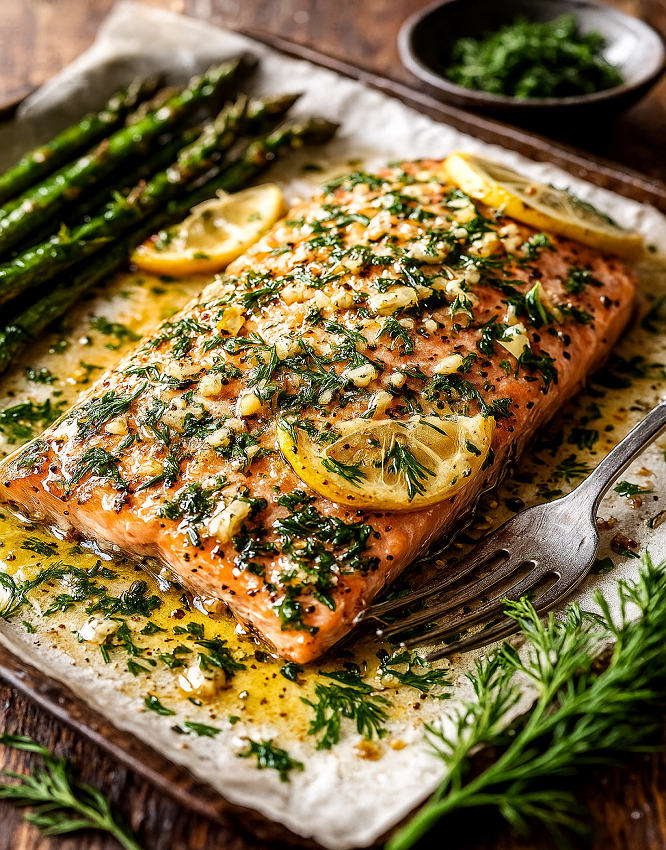
Ingredients (4 servings):
- 4 salmon fillets (about 6 oz each)
- 2 tbsp olive oil
- 3 cloves garlic, minced
- 2 tbsp fresh dill, chopped (or 2 tsp dried dill)
- 1 lemon (zest and juice)
- Salt and pepper, to taste
- Lemon wedges, for serving
Instructions:
- Preheat oven to 375°F (190°C). Line a baking tray with parchment paper.
- Place salmon fillets skin-side down.
- In a small bowl, whisk olive oil, garlic, dill, lemon zest, lemon juice, salt, and pepper.
- Brush mixture over salmon fillets.
- Bake for 15–18 minutes, until salmon flakes easily with a fork.
- Serve hot with lemon wedges and a side of roasted vegetables or salad.
12. Lamb Kofta with Yogurt Sauce
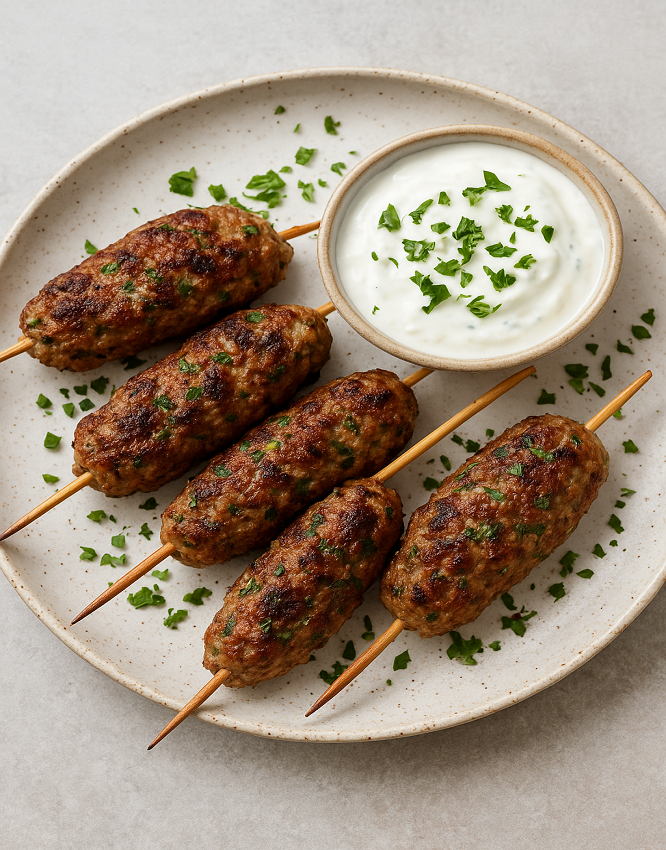
Ingredients (4 servings):
Kofta:
- 1 lb ground lamb
- 1 small onion, finely grated
- 3 cloves garlic, minced
- 2 tbsp fresh parsley, chopped
- 1 tbsp fresh mint, chopped (optional)
- 1 tsp ground cumin
- 1 tsp ground coriander
- ½ tsp paprika
- ½ tsp chili flakes (optional)
- Salt and pepper, to taste
- 1 tbsp olive oil (for cooking)
Yogurt Sauce:
- 1 cup plain Greek yogurt
- 1 tbsp lemon juice
- 1 small cucumber, grated and squeezed dry
- 1 tbsp fresh dill or mint, chopped
- Salt and pepper, to taste
Instructions:
- In a large bowl, combine all kofta ingredients (except olive oil). Mix well.
- Shape mixture into small oval patties or skewered sausages.
- Heat olive oil in a skillet or grill pan over medium heat. Cook koftas for 8–10 minutes, turning until browned and cooked through.
- Mix all yogurt sauce ingredients in a bowl.
- Serve koftas hot with yogurt sauce, pita bread, and salad.
13. Beef and Spinach Curry
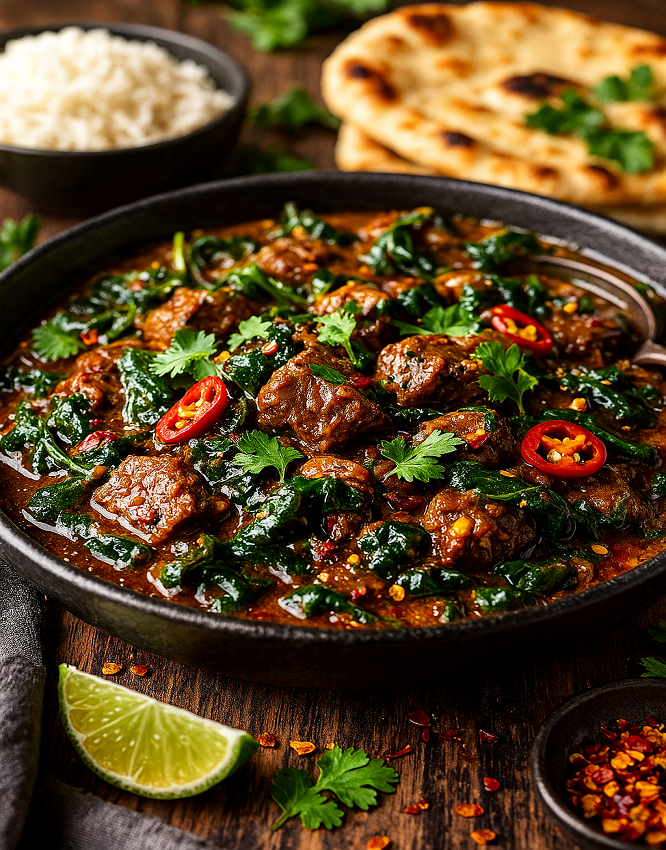
Ingredients (4–6 servings):
- 1.5 lbs beef chuck or stewing beef, cut into cubes
- 2 tbsp vegetable oil
- 2 onions, finely chopped
- 3 cloves garlic, minced
- 1-inch piece ginger, grated
- 2 tbsp curry powder (or a mix of cumin, coriander, turmeric, chili powder)
- 1 can (14 oz) diced tomatoes
- 1 cup beef broth
- 6 cups fresh spinach, roughly chopped
- Salt and pepper, to taste
- Fresh cilantro, for garnish
Instructions:
- Heat oil in a large pot over medium heat. Sauté onions until golden brown.
- Add garlic and ginger, cook for 1 minute. Stir in curry powder.
- Add beef, sear until browned on all sides.
- Stir in tomatoes and beef broth. Cover and simmer on low heat for 1.5–2 hours, until beef is tender.
- Add spinach, stir until wilted. Season with salt and pepper.
- Garnish with cilantro and serve with rice or naan.
14. Garlic Butter Shrimp with Couscous
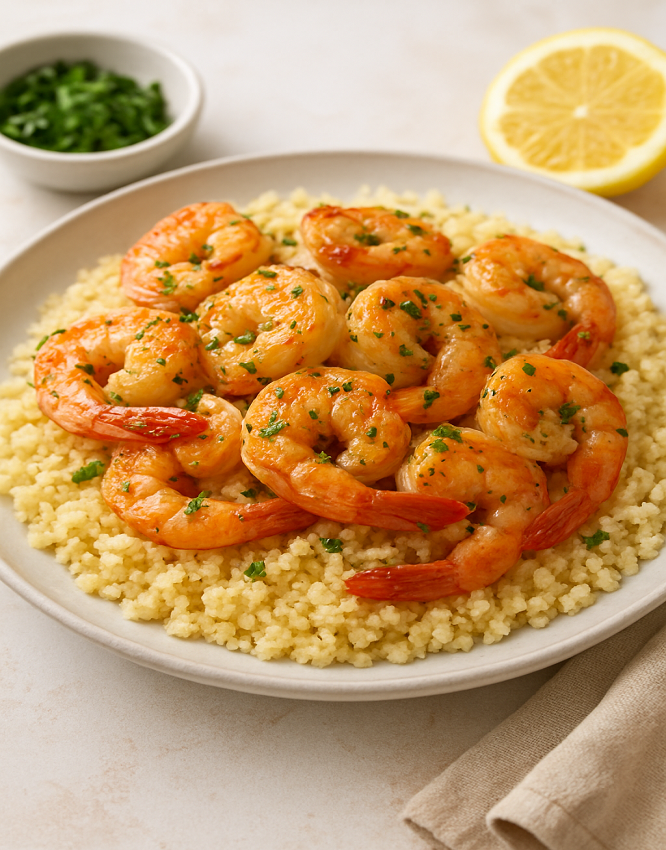
Ingredients (4 servings):
Shrimp:
- 1 lb large shrimp, peeled and deveined
- 3 tbsp unsalted butter
- 4 cloves garlic, minced
- ½ tsp paprika
- Juice of 1 lemon
- Salt and pepper, to taste
- Fresh parsley, chopped
Couscous:
- 1 cup couscous
- 1 ¼ cups chicken or vegetable broth
- 1 tbsp olive oil
- ½ tsp salt
Instructions:
- Prepare couscous: Bring broth, olive oil, and salt to a boil. Stir in couscous, cover, and remove from heat. Let sit for 5 minutes, then fluff with a fork.
- Heat butter in a skillet over medium heat. Add garlic, cook for 30 seconds.
- Add shrimp, paprika, salt, and pepper. Cook 2–3 minutes per side until pink.
- Squeeze lemon juice over shrimp and sprinkle with parsley.
- Serve shrimp over couscous with extra lemon wedges.
15. Vegetable Biryani
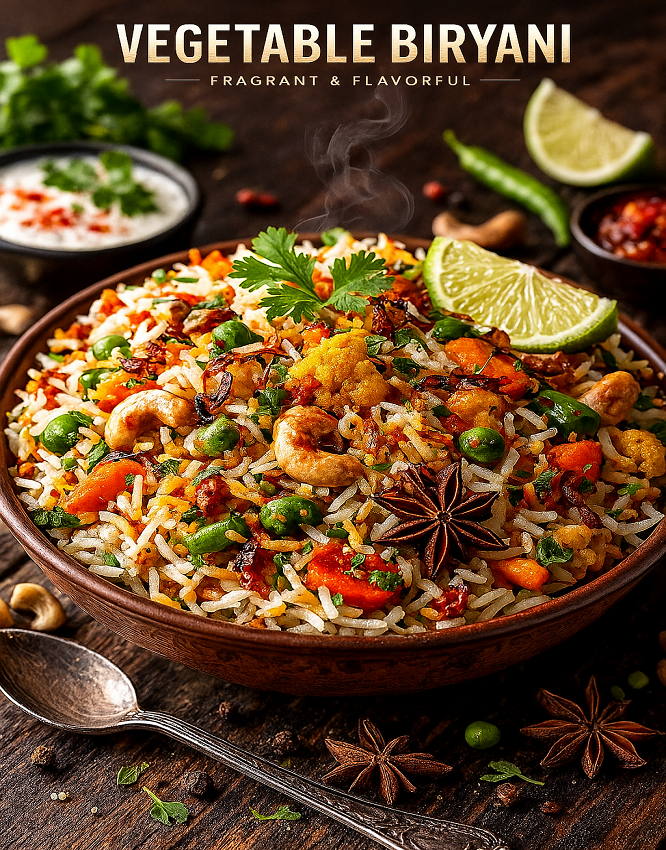
Ingredients (4–6 servings):
- 2 cups basmati rice
- 3 tbsp ghee or oil
- 2 onions, thinly sliced
- 2 cloves garlic, minced
- 1-inch piece ginger, grated
- 1 cup mixed vegetables (peas, carrots, green beans, potatoes)
- 1 tomato, chopped
- 1 tsp cumin seeds
- 1 tsp garam masala
- 1 tsp ground coriander
- ½ tsp turmeric
- ½ tsp chili powder
- 4 cups vegetable broth
- ¼ cup plain yogurt
- 2 tbsp fresh cilantro, chopped
- 2 tbsp fresh mint, chopped
- Fried onions and cashews, for garnish
Instructions:
- Rinse rice until water runs clear. Soak for 30 minutes, then drain.
- Heat ghee/oil in a large pot. Fry onions until golden. Remove half for garnish.
- Add garlic, ginger, cumin seeds, and spices. Cook for 1 minute.
- Stir in vegetables and tomato. Cook for 5 minutes.
- Add rice, broth, and yogurt. Stir gently.
- Cover and simmer on low for 20–25 minutes, until rice is cooked and liquid absorbed.
- Garnish with fried onions, cashews, cilantro, and mint. Serve with raita.
Dessert Halal Recipes
16-Baklava with Honey and Nuts
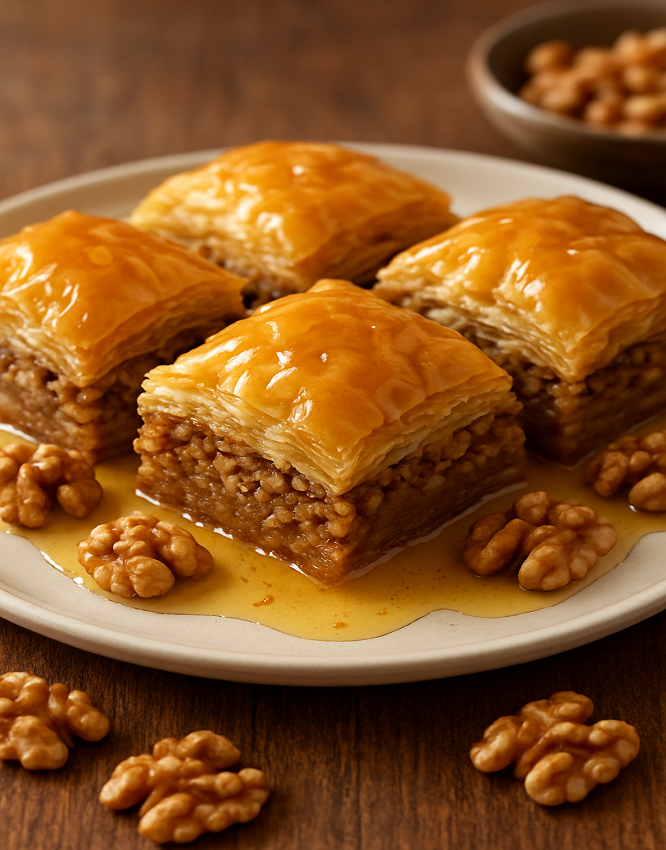
Ingredients:
- 1 package phyllo dough (about 16 oz), thawed
- 2 cups mixed nuts (walnuts, pistachios, almonds), finely chopped
- 1 cup unsalted butter, melted
- 1 tsp cinnamon powder
- 1 cup sugar
- 1 cup water
- ½ cup honey
- 1 tsp lemon juice
Instructions:
- Preheat oven to 350°F (175°C). Grease a 9×13-inch baking dish.
- In a bowl, mix chopped nuts with cinnamon.
- Layer 8 sheets of phyllo dough in the baking dish, brushing each sheet with melted butter.
- Spread 2–3 tbsp of the nut mixture evenly over the dough.
- Continue layering phyllo sheets (2 sheets at a time, each brushed with butter) and nuts until all are used. Finish with about 8 layers of phyllo on top.
- Using a sharp knife, cut the baklava into diamond or square shapes before baking.
- Bake for 45–50 minutes, until golden brown and crisp.
- While baking, prepare syrup: In a saucepan, combine sugar, water, honey, and lemon juice. Bring to a boil, reduce heat, and simmer for 10 minutes. Cool slightly.
- Remove baklava from oven and immediately pour syrup evenly over the hot pastry.
- Let it soak for at least 4 hours (preferably overnight) before serving.
17-Rice Pudding with Saffron and Cardamom
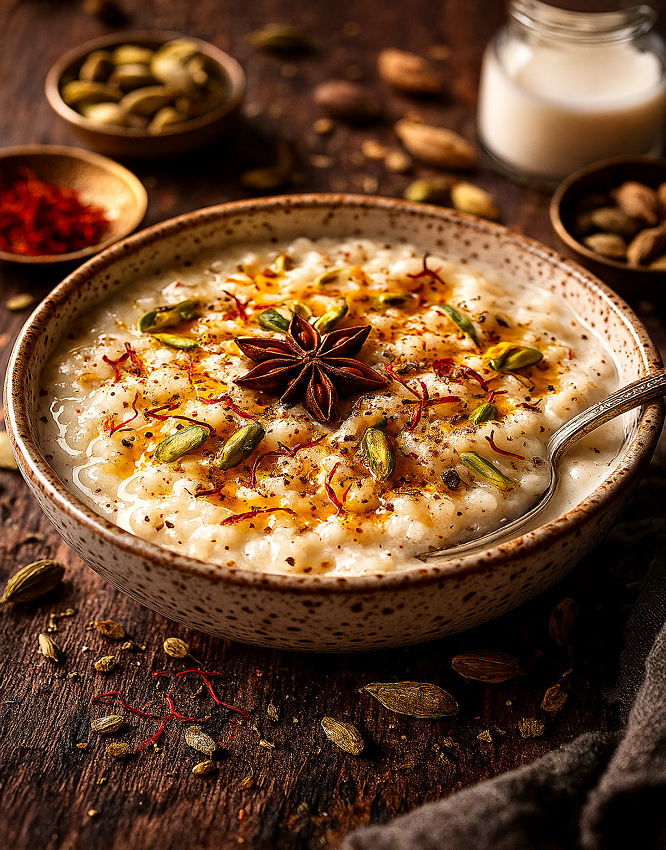
Ingredients:
- 1 cup basmati rice
- 4 cups whole milk
- ½ cup sugar (adjust to taste)
- 4–5 green cardamom pods, lightly crushed
- 1 pinch saffron threads (soaked in 2 tbsp warm milk)
- 2 tbsp rose water (optional)
- 2 tbsp chopped pistachios or almonds (for garnish)
Instructions:
- Rinse rice and soak in water for 30 minutes, then drain.
- In a heavy-bottomed pot, bring milk to a boil. Add drained rice and cardamom pods.
- Cook on low heat, stirring often, until the rice is tender and the pudding thickens (30–40 minutes).
- Stir in sugar, saffron milk, and rose water. Simmer for another 5–10 minutes.
- Remove from heat, discard cardamom pods, and let cool slightly.
- Serve warm or chilled, garnished with chopped nuts.
18-Halal Tiramisu (Non-Alcoholic Version)
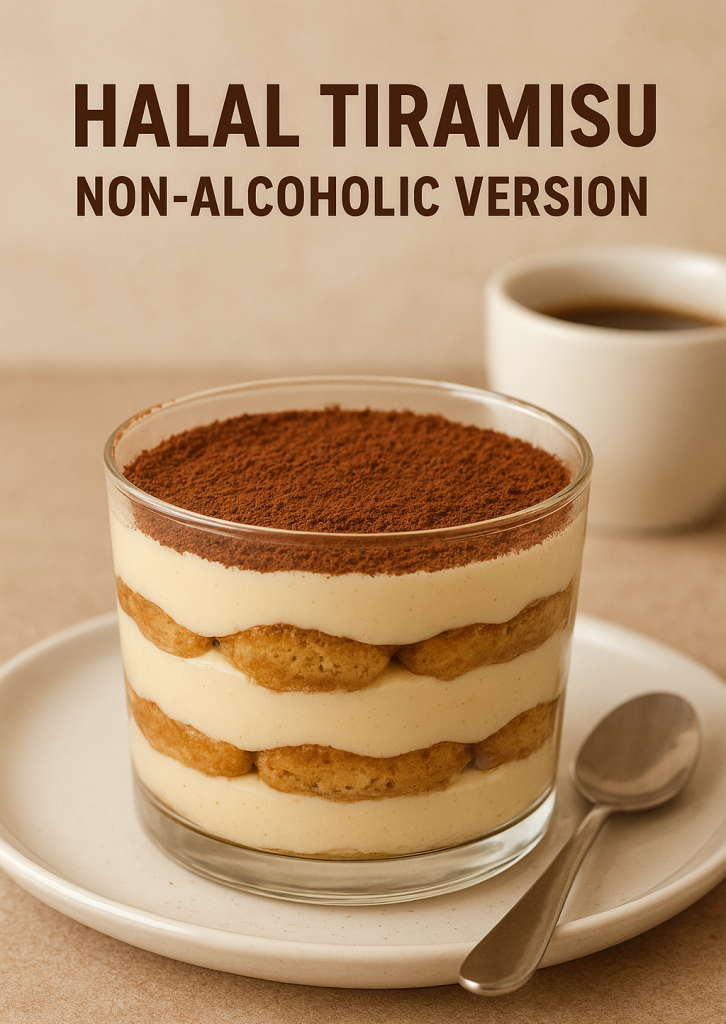
Ingredients:
- 1 package halal ladyfinger biscuits (savoiardi)
- 1 ½ cups brewed strong coffee (or decaf), cooled
- ½ cup sugar
- 4 large egg yolks
- 8 oz mascarpone cheese (or cream cheese substitute)
- 1 cup heavy cream (whipped)
- 1 tsp vanilla extract
- Unsweetened cocoa powder, for dusting
Instructions:
- Brew coffee and let it cool. Pour into a shallow dish.
- In a heatproof bowl over simmering water, whisk egg yolks and sugar until pale and thick (about 5 minutes). Remove from heat and let cool.
- Beat in mascarpone and vanilla until smooth.
- Fold in whipped cream gently to create a light mousse-like mixture.
- Quickly dip each ladyfinger into the cooled coffee (do not soak). Arrange a layer in the bottom of a glass dish.
- Spread half of the mascarpone mixture over the biscuits.
- Add another layer of dipped ladyfingers, then top with remaining mascarpone cream.
- Cover and refrigerate for at least 6 hours (overnight preferred).
- Before serving, dust generously with cocoa powder.
7-day halal meal plan
Here’s a 7-day halal meal plan using the 15 recipes I shared earlier. Each day includes breakfast, lunch, and dinner with variety and balance:
Day 1
- Breakfast: Shakshuka (Eggs in Tomato Sauce)
- Lunch: Grilled Lemon Herb Chicken with salad
- Dinner: Vegetable Biryani
Day 2
- Breakfast: Quinoa Tabbouleh Salad
- Lunch: Moroccan Chickpea Stew with flatbread
- Dinner: Baked Salmon with Garlic and Dill
Day 3
- Breakfast: Mediterranean Hummus Wrap
- Lunch: Chicken and Vegetable Stir-Fry
- Dinner: Beef and Spinach Curry with rice
Day 4
- Breakfast: Spiced Lentil Soup
- Lunch: Stuffed Bell Peppers with Rice and Vegetables
- Dinner: Garlic Butter Shrimp with Couscous
Day 5
- Breakfast: Honey Glazed Carrots with whole grain toast
- Lunch: Roasted Cauliflower with Tahini and greens
- Dinner: Lamb Kofta with Yogurt Sauce and pita
Day 6
- Breakfast: Shakshuka (Eggs in Tomato Sauce)
- Lunch: Moroccan Chickpea Stew
- Dinner: Grilled Lemon Herb Chicken with roasted vegetables
Day 7
- Breakfast: Quinoa Tabbouleh Salad
- Lunch: Chicken and Vegetable Stir-Fry
- Dinner: Vegetable Biryani with yogurt raita
This plan balances protein, healthy carbs, and vegetables while keeping everything halal-friendly.
shopping list for the 7-day halal meal plan:
This list should cover all meals for one week. Quantities assume cooking for about 2–3 people.
Proteins
- Chicken breast or thighs (about 2–3 kg total)
- Salmon fillets (4–5 pieces)
- Ground beef (500 g)
- Ground lamb (500 g)
- Shrimp (500 g, peeled & deveined)
- Eggs (12–14)
- Plain Greek yogurt (500 g)
Vegetables
- Tomatoes (10–12 medium)
- Cherry tomatoes (optional, for salads)
- Bell peppers (6–8, mixed colors)
- Spinach (2 bunches or 400 g)
- Carrots (6–8 medium)
- Cauliflower (1 large head)
- Zucchini (2 medium)
- Onions (6–8 medium)
- Garlic (2–3 bulbs)
- Fresh parsley (2 bunches)
- Fresh cilantro (1 bunch)
- Fresh dill (1 bunch, optional for salmon)
Grains & Legumes
- Basmati rice (1–1.5 kg)
- Quinoa (500 g)
- Lentils (red or green, 500 g)
- Chickpeas (2 cans or 500 g dried)
- Couscous (500 g)
- Whole grain wraps or pita bread (pack of 6–8)
Pantry & Spices
- Olive oil (or preferred cooking oil)
- Salt & black pepper
- Paprika
- Cumin
- Turmeric
- Coriander powder
- Cinnamon (small amount for biryani)
- Chili powder or flakes (optional for spice)
- Honey (small jar)
- Tahini (1 jar)
Other & Flavorings
- Lemons (5–6)
- Tomato paste (1 small can)
- Raita or plain yogurt (extra for side with biryani/kofta)
Halal 7-Day Prep Plan
Here’s a day-by-day prep plan for your 7-day halal meal plan. This will save you time and keep meals fresh while reducing daily cooking stress.
With this plan, you only need to batch cook 2–3 times a week, and most other meals take under 20 minutes.
General Prep (Do Once at Start of Week)
- Cook a big batch of basmati rice (store in fridge, reheat as needed).
- Boil/cook chickpeas (if using dried) or drain canned ones.
- Wash, chop, and store herbs (parsley, cilantro, dill) in airtight containers.
- Pre-chop onions, garlic, bell peppers, carrots and store in fridge.
Day 1
- Breakfast: Shakshuka → Cook fresh (10–15 min).
- Lunch: Grilled Lemon Herb Chicken → Grill/cook extra portions to reuse for Day 6 dinner.
- Dinner: Vegetable Biryani → Make a large batch, save half for Day 7 dinner.
Day 2
- Breakfast: Quinoa Tabbouleh Salad → Make enough for 2 servings, use again on Day 7 breakfast.
- Lunch: Moroccan Chickpea Stew → Cook double, save half for Day 6 lunch.
- Dinner: Baked Salmon with Garlic & Dill → Cook fresh (20 min).
Day 3
- Breakfast: Mediterranean Hummus Wrap → Prep hummus ahead, assemble fresh.
- Lunch: Chicken & Vegetable Stir-Fry → Cook fresh, but pre-cut veggies help (15 min).
- Dinner: Beef & Spinach Curry → Make double batch, freeze/save for later if needed.
Day 4
- Breakfast: Spiced Lentil Soup → Cook a pot, refrigerate for 2–3 servings.
- Lunch: Stuffed Bell Peppers → Can be prepped night before, just bake at lunchtime.
- Dinner: Garlic Butter Shrimp with Couscous → Cook fresh (quick 15 min).
Day 5
- Breakfast: Honey Glazed Carrots with toast → Cook carrots night before, reheat.
- Lunch: Roasted Cauliflower with Tahini → Roast extra cauliflower, use leftovers as side later.
- Dinner: Lamb Kofta with Yogurt Sauce → Shape koftas in advance, cook fresh (20 min).
Day 6
- Breakfast: Shakshuka (again) → Quick fresh cook.
- Lunch: Moroccan Chickpea Stew (leftover from Day 2).
- Dinner: Grilled Lemon Herb Chicken (leftover from Day 1).
Day 7
- Breakfast: Quinoa Tabbouleh Salad (leftover from Day 2).
- Lunch: Chicken & Vegetable Stir-Fry → Fresh cook (quick).
- Dinner: Vegetable Biryani (leftover from Day 1).
Your printable Halal 7-Day Meal Plan calendar is ready!
You can download it here: Halal_7_Day_Meal_Plan.pdf
Conclusion
Exploring halal recipes opens the door to a rich culinary tradition that emphasizes not only taste but also mindfulness in food preparation and consumption. While halal simply means “permissible,” it reflects values of cleanliness, ethical sourcing, and balance that many people—Muslim or not—can appreciate. From quick family-friendly dinners to elaborate festive meals, halal cooking is as diverse as the cultures that inspire it.
What makes halal recipes particularly versatile is their adaptability. Whether you enjoy meat-based dishes, prefer vegetarian meals, or follow a vegan lifestyle, there are countless halal options available. With a little creativity, you can prepare meals that are both nourishing and in line with halal principles.
Ultimately, halal food is about more than just dietary rules—it’s about fostering a conscious and inclusive approach to eating. By choosing halal-certified products and experimenting with halal-friendly recipes, you not only expand your culinary horizons but also share in a tradition that brings people together around the table.
FAQs
Can non-Muslims enjoy halal recipes?
Absolutely! Halal recipes are not restricted to Muslims—anyone can enjoy them. They’re often wholesome, flavorful, and rooted in diverse cuisines from around the world.
Are halal recipes healthier than regular recipes?
Halal itself refers to what is permissible under Islamic dietary laws, not necessarily the healthiness of food. However, many halal practices emphasize cleanliness, humane animal treatment, and avoiding harmful ingredients, which can contribute to healthier meals.
How to identify halal-certified products?
Look for official halal certification symbols on packaging, which vary by country. You can also check ingredients lists to ensure no alcohol, pork, or other non-halal substances are included. When in doubt, consult halal certification bodies or trusted halal directories.
What are quick halal dinner ideas?
Some easy halal dinner ideas include:
- Grilled chicken with spiced rice
- Chickpea and vegetable curry
- Beef stir-fry with noodles
- Lentil soup with flatbread
- Baked salmon with roasted vegetables
Can halal recipes be made vegetarian or vegan?
Yes! Vegetarian and vegan dishes are naturally halal as long as they don’t contain alcohol or other non-halal additives. From lentil stews to veggie stir-fries, you can easily create plant-based meals that fit halal guidelines.


I love how simple and clear these recipes are! Perfect for anyone looking to maintain a halal diet without spending hours in the kitchen.
I tried the grilled chicken recipe, and it turned out amazing! My family loved it. Can’t wait to try more from this list.
These recipes are great, but it would be even more helpful if you could include calorie counts or nutritional information for each dish
This collection is exactly what I needed! Everything looks so delicious—I’m starting with the lamb stew tonight!
good thanks
nice